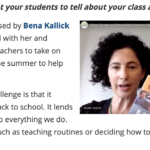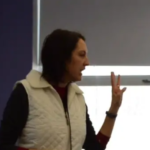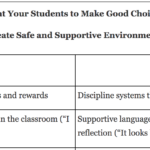Are you a teacher struggling to keep your students engaged? You’re not alone. A team of teachers at Sandown North Elementary School faced similar challenges, witnessing a decline in student engagement and an uptick in students that were dysregulated. Instead
What Are We Doing Today in Physical Education?
“What are we doing today?” is the most frequently asked question by my middle school students while entering the gym to get ready for class. After my response, students will usually either
“How’d it go?” On the surface, it is such a basic question. I’ve been asked that question plenty of times in my life. After a sports game, doctor’s appointment, or school meeting, not to mention that nerve-wracking best man’s speech
In the final episode of Season I of Ted Lasso, players are somber and nervous heading into a do-or-die match against a superior team. Ted decides they all need to try something new, so he invites the players to name
Don’t look now, but the end of the school year isn’t far away. Of course, we know how important the first weeks of school are, but what about the last weeks of school? Surely, this is just as important a
As schools welcome more and more students back through their doors, we’re all trying to figure out the best way to do so. It seems as though there are two wildly different needs we must address. As I talk with
You want at-home learning to feel purposeful and engaging for students, but you don’t want to further overwhelm yourself with work. What if there was a way to both boost student engagement and reduce the daily assigning, correcting, and keeping
What if there was a learning strategy that boosted student engagement, had many (many!) academic benefits for students, and reduced teacher planning and correcting/grading time? Great news! There is–and it’s a tried and true strategy you have probably been using
It might be the understatement of the summer that teachers, students, parents, and administrators are anxious about the upcoming school year.
In addition to the priorities of health, safety, and equity of access to education in this COVID-19 period, distance
What might schools look like in the fall?
We can learn from schools that have already welcomed children back to school.
In the United States, many of us (teachers, parents, and students) are filled with anxiety about what the
I was delighted to join a group of deep thinkers for an in-depth panel discussion about leaner-centered education. Hosted by Julie Mountcastle of the Slate School, this conversation is rich and engaging. You’ll hear about the importance of cherishing children’s
A Conversation with Mike Anderson, Little Things First
This is part 3 of a four-part series on how to support educators in the midst of the coronavirus pandemic.
In this conversation with the Little Things First podcast hosts, Tracy
A high school math teacher is recording short lessons on his phone in his basement, using a dry erase board and marker as he explains new math concepts. He posts the videos and then offers one-on-one and small group coaching
You’ve spent the whole year building a community of learners. You’ve established rules and routines to help learners manage themselves and work well with each other. Now, with schoolwork potentially moving offsite, you still want to support your students as
The Dilemma
You want to offer students choices about what they learn or how the learn it. Engagement would be higher and you could offer differentiated options to meet the needs of various learners. However, you’re saddled with a scripted
Tell a story that you would want your students to tell about your class at the end of the year.
This compelling challenge was posed by Bena Kallick on a recent video interview I had with her and Allison Zmuda.
The way we introduce learning options to students can make or break a choice experience for students. In this blog post, you’ll learn some practical strategies and ideas from Maggie West, a fifth-grade teacher in Conway, Massachusetts. To get
“If I give my students choice, I’m worried they’re going to make bad choices,” I often hear teachers say. “They’re just going to choose the easiest option. Or, they’re going to choose what their friends choose.”
There’s no doubt that
Rick Gifford knew that a worksheet where students define words and then use them in a sentence wasn’t the most engaging way for them to learn and practice math vocabulary. He wanted to spruce things up and give his students
In survey after survey, business leaders are clear about what they’re looking for in employees. They want creative, dynamic, and independent thinkers. They want people who work well with a variety of people. And, importantly, they don’t want to hire
How Sharing Control of Learning with Students Makes Differentiation Better
Too often, differentiation (especially when it’s called differentiated instruction) places nearly all of the responsibility and work for differentiation in the teacher’s court. This often results in teachers feeling like
One of the most exciting and enjoyable ways to differentiate learning for students is to lead them through a process of independent research. When students get to dig deeply into something they’re passionate about, they have the drive and stamina
One of the most devastating effects of the standardization movement—with its pressures to conform and emphasis on accountability through high-stakes testing—has been the stripping of teacher autonomy—our power to make informed decisions about how best to meet the needs of
Note: This article first appeared on Learning Personalized in April, 2016: http://www.learningpersonalized.com/students-learn-choose-choose-learn/. Thanks go out to my friend and colleague, Allison Zmuda, who originally published the post!
I was recently working with a group of high school teachers, and they
You have just finished teaching a lesson, and as you direct students to get started on their work, a familiar chorus echoes across the room, causing your heart to sink.
What do we get for doing this?
Do we have















